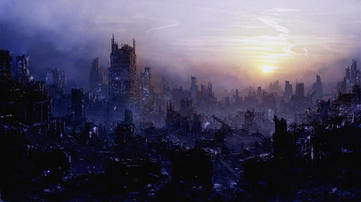
I love how Tsing verbalizes the frontier as ideology. Her description is very close to how we're discussing the concept of frontier in my history class this term (history of the American West), from the creation of wilderness to be conquered/salvaged, its "inert" landscape to be "discovered" and subsequently "dismembered and packaged" (29).
One of the reasons I'm taking that history class, and one of the reasons I love Tsing's description, is because part of my overall diss work looks at how the "frontier" continues to manifest in popular culture through the post-apocalyptic. So many representations of the post-apocalyptic landscape include a defunct urban setting where "the wilderness" is beginning to creep back in, sometimes violently. I'm thinking of I Am Legend, where former zoo animals are roaming the dead streets of New York City, or A.I., where again New York City is mostly flooded. Compare with some more rural pA landscapes such as in the miniseries The Stand (and the Stephen King book on which it is based), where the plague survivors tend to run around the entire US countryside and all the weather is the same (from New England to Boulder, CO to Las Vegas, with all of the Midwest in between). The landscape's main function as a character in these representations is either to remain "inert" and something that survivors can pass through/ignore, or as a barrier characterized by some kind of deadness (Cormac McCarthy's The Road is a good example).
I'm still working through these connections, but I think it's important for me to think about how the pA wasteland functions as a new frontier, of sorts -- how that frontier differs from the frontier that allows for resource extraction, how audiences respond to this "new" frontier, and how that notion of frontier informs how they understand survival for themselves.
One point Tsing makes that is blowing my mind right now (in terms of usefulness for my own work) is its strange temporality. She says, "The frontier is not a philosophy but rather a series of historically nonlinear leaps and skirmishes" (33). The influence of Frederick Jackson Turner is still present, I would say, in the way many people think about frontier. Even if it is a creation, it still acts for many in a linear way. In pA literature, the landscape is often presented as a "back to frontier" scenario, which is simplified as a "back to wilderness" scenario. But Tsing is giving me different ways to think about various frontiers, and it's exciting to see how they might apply to our creative landscapes.
(Blog post is mostly way off topic from the book as a whole, I know, but this is where my brain goes quite often -- especially when I'm sick. Weeee!)
One of the reasons I'm taking that history class, and one of the reasons I love Tsing's description, is because part of my overall diss work looks at how the "frontier" continues to manifest in popular culture through the post-apocalyptic. So many representations of the post-apocalyptic landscape include a defunct urban setting where "the wilderness" is beginning to creep back in, sometimes violently. I'm thinking of I Am Legend, where former zoo animals are roaming the dead streets of New York City, or A.I., where again New York City is mostly flooded. Compare with some more rural pA landscapes such as in the miniseries The Stand (and the Stephen King book on which it is based), where the plague survivors tend to run around the entire US countryside and all the weather is the same (from New England to Boulder, CO to Las Vegas, with all of the Midwest in between). The landscape's main function as a character in these representations is either to remain "inert" and something that survivors can pass through/ignore, or as a barrier characterized by some kind of deadness (Cormac McCarthy's The Road is a good example).
I'm still working through these connections, but I think it's important for me to think about how the pA wasteland functions as a new frontier, of sorts -- how that frontier differs from the frontier that allows for resource extraction, how audiences respond to this "new" frontier, and how that notion of frontier informs how they understand survival for themselves.
One point Tsing makes that is blowing my mind right now (in terms of usefulness for my own work) is its strange temporality. She says, "The frontier is not a philosophy but rather a series of historically nonlinear leaps and skirmishes" (33). The influence of Frederick Jackson Turner is still present, I would say, in the way many people think about frontier. Even if it is a creation, it still acts for many in a linear way. In pA literature, the landscape is often presented as a "back to frontier" scenario, which is simplified as a "back to wilderness" scenario. But Tsing is giving me different ways to think about various frontiers, and it's exciting to see how they might apply to our creative landscapes.
(Blog post is mostly way off topic from the book as a whole, I know, but this is where my brain goes quite often -- especially when I'm sick. Weeee!)
 RSS Feed
RSS Feed
